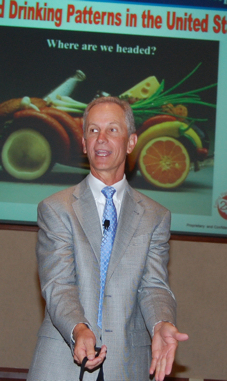Americans are eating more meals at home and fewer in restaurants as the recession drags on and incomes stagnate, food analyst Harry Balzer told the Chicken Marketing Seminar in Squaw Valley, California, this week.
The number of meals prepared and consumed at home is projected at 889 per person per year for 2011, the highest level in almost 20 years, he said. Restaurant patronage has dropped to 192 meals purchased at a restaurant, down from its peak of 211 in 2001, he said, and most of those are carryout. Actual dining in a restaurant has fallen to 74 meals purchased per person, he said. McDonald’s is by far the most popular restaurant in the country, he said.
Balzer is chief industry analyst and vice president of The NPD Group based in Chicago and cited data from NPD’s 25th annual report, which is based on consumer food diaries and a variety of other studies.
Chicken occupies a prominent place on restaurant orders, he said, with 18.1 percent of all orders including chicken. That is down slightly from the peak of 18.7 in 2009. Chicken sandwiches are popular, included in 6.4 percent of all restaurant orders.
The percentage of all restaurant orders that “include an item called fried chicken” has been cut in half in the last 20 years to 2.2 percent of all restaurant orders, Balzer said. However, the percentage of orders that include nuggets and strips, breaded sandwiches, and wings–items that are usually prepared in hot oil–has increased. The total of chicken items prepared in a fryer stands at 12.7 percent of restaurant orders, plus 3.9 percent for non-fried items such as grilled sandwiches, rotisserie, and barbecue.
Cutting back on restaurant dining is one way for consumers to save money, he said. The consumer food dollar is 53 percent at-home and 47 percent foodservice, he said, and spending on food is about 9.5 percent of disposable personal income. People simply do not have more money to spend on food, Balzer said, since median household incomes are hovering below $50,000 per year — $49,777 in 2009, the last year for which data are available, he said. That is below the 1999 peak of about $52,000, he said.
Yogurt could be considered the “food of the decade” since consumption has risen from 17.5 percent of consumers eating yogurt at least once in a two-week period in 2000 to 31.5 percent in 2011, an increase of 14 percentage points, he said. Consumption of breakfast bars and other bars, bottled water, and chips are also up significantly, while consumption of carbonated soft drinks has slipped, he said, although 74 percent of consumers still drink them. He predicted that oatmeal will be the fastest-growing food item next year because McDonald’s is featuring it.


